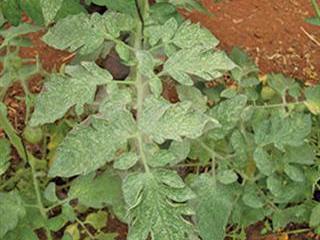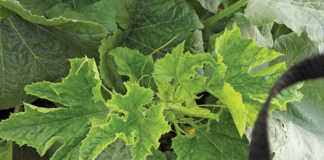
There are more than 1 000 species of whitefly, all belonging to the family Aleyrodidae. The insects feed on the undersides of the leaves and so damage the plant. They also produce honeydew on which a sooty mould develops, giving the plant a black colour. This affects growth. The whitefly isn’t usually a regular pest and, as with so many other insects, it’s naturally controlled by parasitoid wasps.
There is therefore a see-saw effect, where the wasps manage to cut the whitefly population to such a low level that their own numbers decline, meaning the whiteflies get an opportunity to increase again. Often, when we find whiteflies without there being parasitoids present, this is because toxic sprays have killed off the wasps. Ironically, they’re far more vulnerable to insecticides than whiteflies, which are notoriously difficult to eradicate with chemicals.
Having said this, though, I should point out there are now some products available which do a very good job. Imidacloprid is one. Previously, one had to do applications every few days to catch the whitefly at a vulnerable stage of its life cycle.
Vectors
If you’re in an area where curly stunt virus occurs, whiteflies should not be tolerated, as they’re vectors for this disease. Use preventative sprays to ensure that whiteflies don’t get a look-in. Where the virus doesn’t occur, light populations can be tolerated, provided the parasitoid wasp Encarsia formosa is present. These minute wasps are black with a yellow abdomen. Look for them by turning over the tomato leaves and examining the whitefly pupae. If these have turned a dark colour, a wasp is inside. Unaffected pupae remain green.

Virtually all the whitefly pupae here have been parasitised – a sign of complete biological control.
If parasitoids are present, it’s just a matter of monitoring the situation to make sure they get the upper hand before damage is done. Not only does E. formosa control whiteflies through laying an egg in each whitefly pupa, it also punctures the pupae with its ovipositors and feeds on the juices within. It can therefore bring the pest under control relatively quickly, provided it makes its appearance early enough.
Mites
In terms of mites, there are a few different ones that attack tomatoes which are all lumped together as red spider mites (Tetranychus urticae). They resemble miniature spiders, can easily be seen with the naked eye, and multiply at a terrific rate, releasing a thread and using the wind to move to other plants – so don’t procrastinate if you find patches of them. Look for tiny white dots on the leaves, as the mites feed from under the leaf initially.
At an advanced stage, webs can be seen between leaves with mites all over them. A farmer once told me he had such an outbreak, even the poles turned red from the masses of mites on them. There are natural predators, including predatory mites, and often these keep the land so clean you don’t even notice mites. It’s well known that outbreaks occur after using pyrethroids or other harsh chemicals to control bollworms, as these kill off the biological control agents as well. A number of products will control mites effectively.
A close look
Another ‘problem mite’ is Aceria anthocoptes, or russet mite, which can’t be seen with the naked eye. The first sign that this pest is present is stems and leaves turning a bronze colour. To confirm that it is russet mite, you’ll need to use a good magnifying glass. The mites will be cone- or pear-shaped. Most mite populations tend to increase in warm, dry conditions, and the russet mite is especially prolific. As noted, these pests can take you by surprise. So whenever you spot an area in your land that looks ‘off’, take a close look to determine the cause.
Contact Bill Kerr at [email protected]. Please state ‘Vegetable production’ in the subject line of your email.












